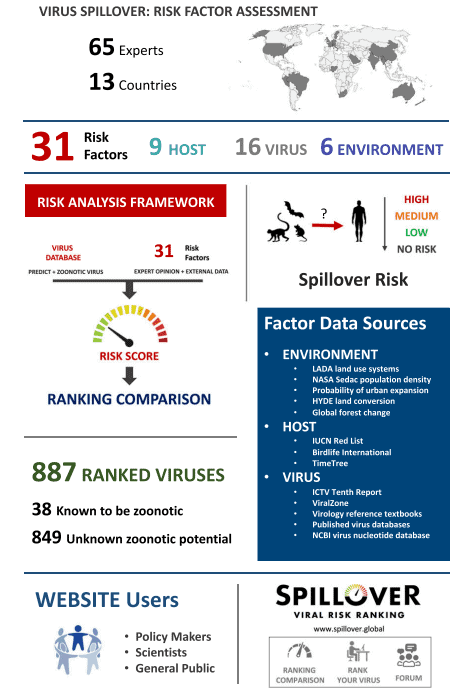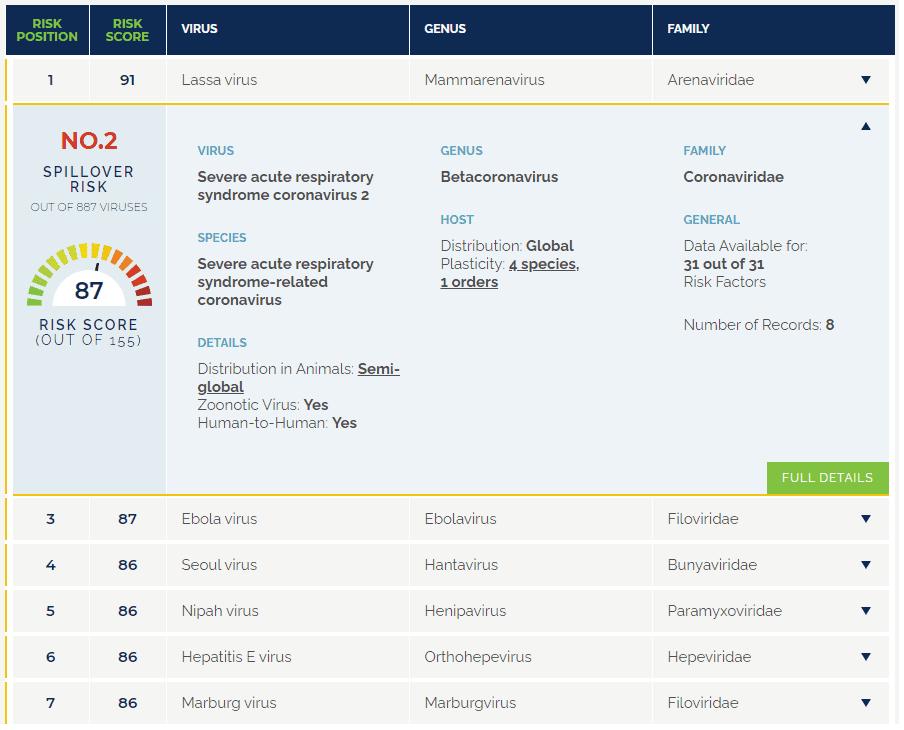
The COVID-19 pandemic caught the world off guard, showing just how woefully unprepared we are against spillovers of zoonotic viruses. But that doesn’t mean we weren’t warned. There are over 500,000 animal viruses that have the potential to cross to humans, and for decades, scientists have been calling the alarm that human activity is increasing the risk of spillover.
“It is highly likely that future SARS or MERS-like coronavirus outbreaks will originate from bats, and there is an increased probability that this will occur in China.” Sounds familiar? That’s the conclusion of a study published in early 2019 that was eerily prescient, and it’s not even the only study to come with this type of warning.
The rest, as they say, is history. The evidence so far indicates that SARS-CoV-2 is a wildlife spillover, with the virus originating in bats in China. Bats go out foraging and have numerous encounters with other animals, such as pangolins, badgers, pigs, and many others. Ultimately, the virus crossed to humans.
One good thing about this pandemic is that there is now an enormous amount of public support for measures meant to contain and avoid new outbreaks — although there’s a good chance this will decline as the imminent threat subsides. With this in mind, researchers at the University of California, Davis, have released a new web app called SpillOver, which ranks hundreds of wildlife viruses by their spillover risk.
“Our tool aims to rank the risks of spillover from newly-discovered viruses. Sadly, the risk of new diseases and another epidemic and pandemic resulting from human behaviors at high-risk transmission interfaces are high if we don’t act now. The tool allows you to create a personalized watchlist for a specific country or type of virus, etc. so that we can be prepared for the next one and help to stop it before human casualties or at least control it at the source,” Jonna Mazet, Professor of Epidemiology and Disease Ecology at the UC Davis School of Veterinary Medicine, told ZME Science.

The ranking is based on data collected from a myriad of sources, including new viruses first detected by PREDICT, a USAID project launched in 2009 designed to assess emerging pandemic threats. Hundreds of scientists and public health experts have already contributed to the database. Crowdsourcing is still available as any scientist can add data to existing viruses or assess the risk of new viruses using the ‘Rank Your Virus’ application in the tool.
Each of the 887 animal viruses compiled in SpillOver, most of which were new to science at the time of inclusion, has a risk score. Those with the highest risk are known zoonotic viruses that have already spilled over from wildlife to humans. For instance, SARS CoV-2 that causes COVID-19 ranks second, between the Lassa and Ebola viruses.

Why would the COVID-causing virus rank lower than Lassa, a virus that causes hemorrhagic fever and kills only 5,000 people a year? That’s because key information about SARS-CoV-2 is still missing, such as the number and range of its host species, which might paint a more accurate picture of the spillover risk for this species of coronavirus.
“SARS-CoV-2 was not discovered until it made people sick. That is the problem that we are trying to solve. We have all of the technology and scientific information we need to safely identify viruses and their transmission risks before they spillover, the world just needs the political will to act,” Mazet said.
Close to the top of the list, there are also newly identified viruses that have yet to spill over, but which nevertheless have a higher risk of becoming zoonotic than some known viruses. Unsurprisingly, many of them are coronaviruses, including a novel coronavirus provisionally named PREDICT_CoV-35, which ranks in the top 20.
It is in identifying such new viruses that have yet to spill over from bats or other animals to humans but have the potential to do so that the tool shines. By highlighting the riskiest viruses, experts can then perform further investigations and local authorities that can enact urgent measures meant to contain any possible viral leak to humans. It’s not too different from risk assessments used by banks and insurance companies to make informed decisions. As the ongoing pandemic has tragically shown, keeping an eye on other viruses like it could mean the difference between a normal life and a new pandemic — maybe even worse than this one.
“The biggest moments were often the most tragic ones — helping countries respond to more than 50 outbreaks of mystery diseases and terrible ones, like Ebola. Of course, the COVID19 pandemic has been the most devastating, but also illustrates the need for information on viruses in advance of spilling over, which is exactly what this tool aims to help us do: be prepared for Disease X,” Mazet said.
Using the open-source tool, anyone can compare and contrast the viruses included in the list. You can also filter the viruses based on certain attributes, such as viruses species, host species, and country of the first detection. Hundreds of scientists have already contributed to SpillOver’s database, and many more are welcome to do so. The more accurate the risk estimates for each virus, the better we can then prioritize efforts meant to contain them.
“We designed the tool to create and evolve the watchlist of newly-detected viruses that have not yet been recognized to cause disease in people but have spillover potential, just as SARS-CoV-2 did before the pandemic began. Identifying the risks associated with new viral discoveries is critical to protect us in the future. So far, we can say that the most life-saving change will come if we alter our behavior near and with wildlife and limit impacts to wildlife habitat to most quickly reduce spillover transmission risk,” Mazet concluded.
The findings were reported in the Proceedings of the National Academy of Sciences.






